Innovative Entrepreneur: The Impact of Steve Jobs on Business and Technology
VerifiedAdded on 2023/06/13
|13
|4091
|118
AI Summary
This essay discusses the early life and challenges that Steve Jobs faced, his creative ideas and collaboration with Wozniak to kick start his business and methods of exploring potential customers and market to grow Apple Inc. The essay concludes with the discussion of his impact on the humanity and human civilization as a whole.
Contribute Materials
Your contribution can guide someone’s learning journey. Share your
documents today.
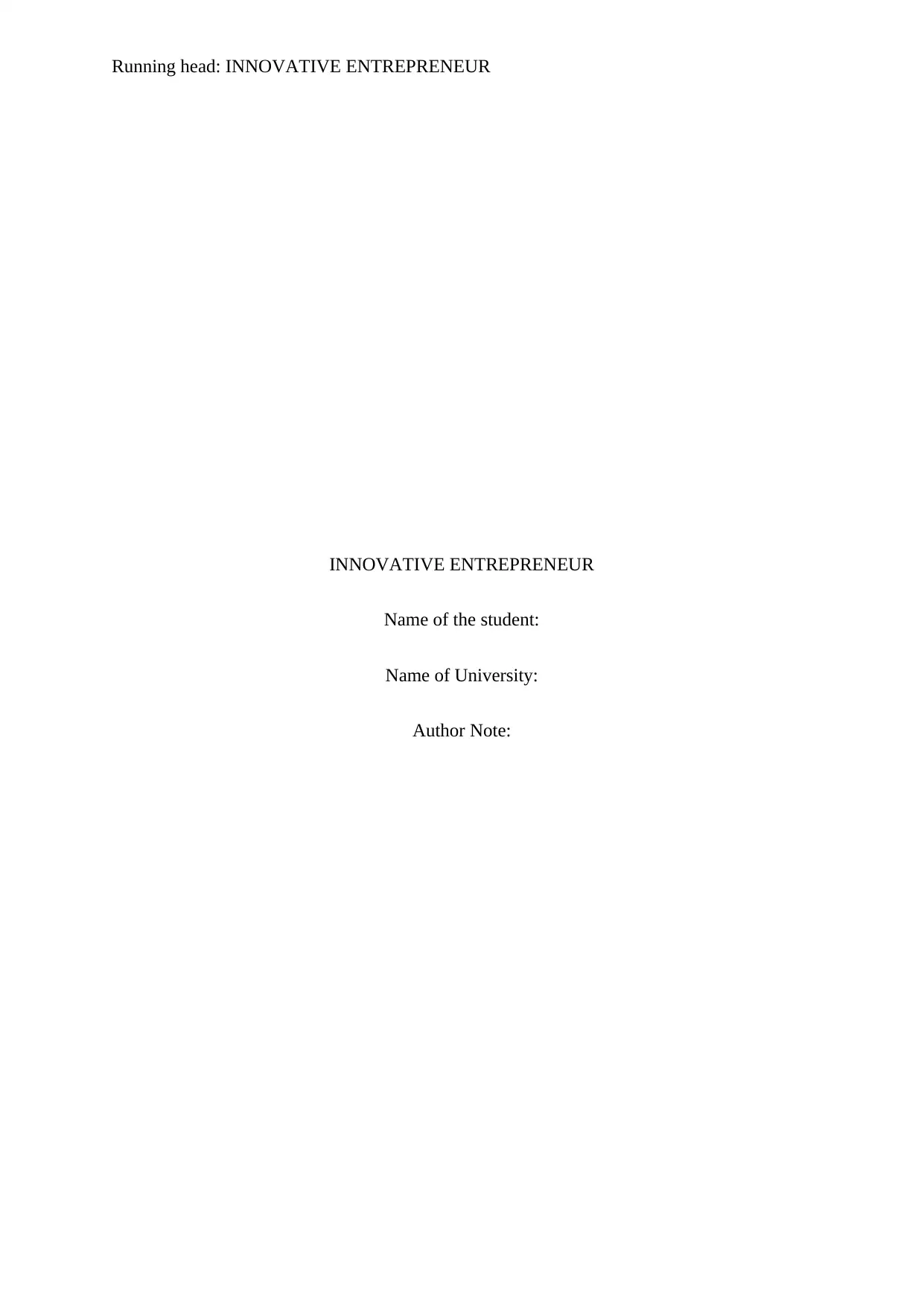
Running head: INNOVATIVE ENTREPRENEUR
INNOVATIVE ENTREPRENEUR
Name of the student:
Name of University:
Author Note:
INNOVATIVE ENTREPRENEUR
Name of the student:
Name of University:
Author Note:
Secure Best Marks with AI Grader
Need help grading? Try our AI Grader for instant feedback on your assignments.
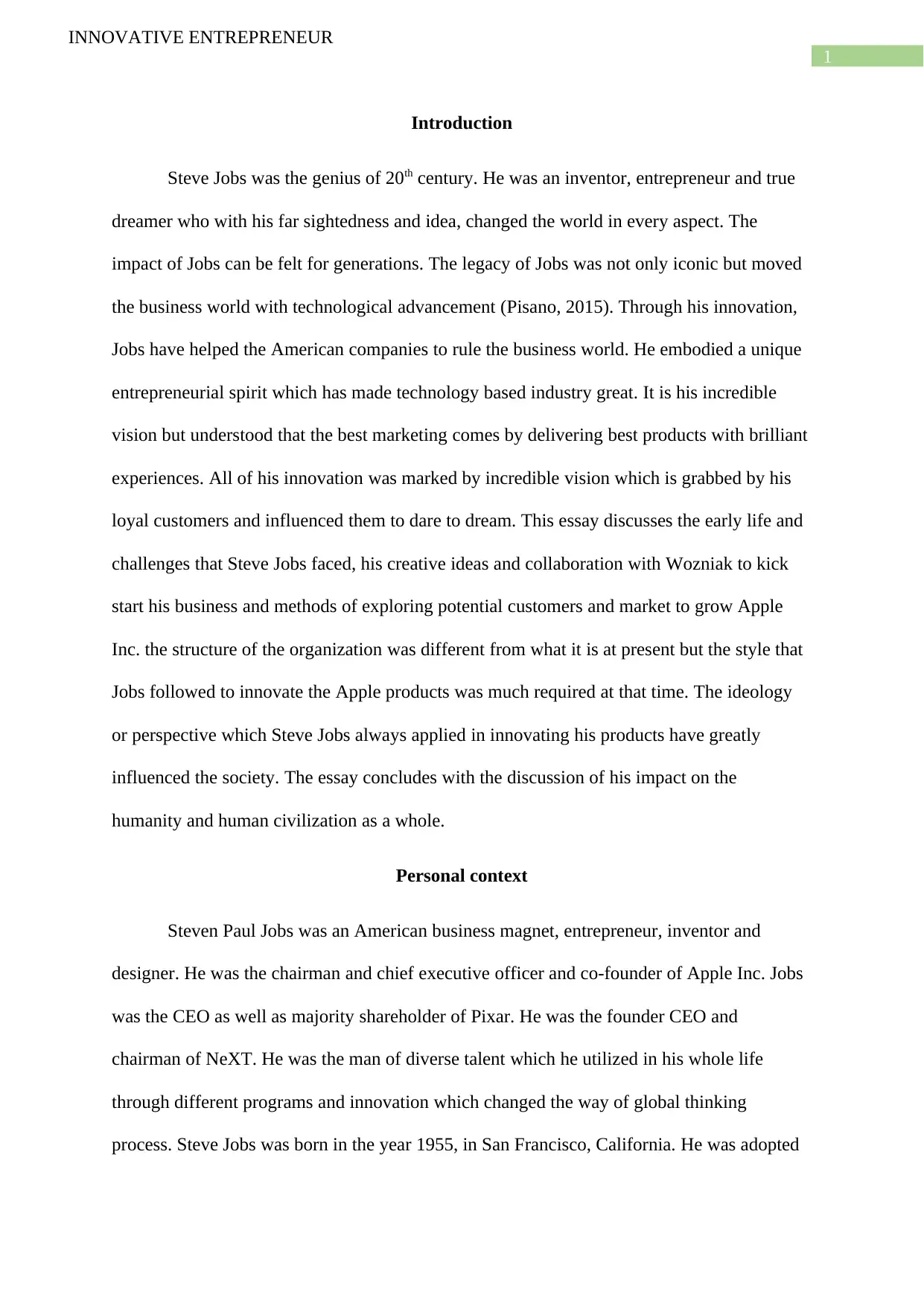
1
INNOVATIVE ENTREPRENEUR
Introduction
Steve Jobs was the genius of 20th century. He was an inventor, entrepreneur and true
dreamer who with his far sightedness and idea, changed the world in every aspect. The
impact of Jobs can be felt for generations. The legacy of Jobs was not only iconic but moved
the business world with technological advancement (Pisano, 2015). Through his innovation,
Jobs have helped the American companies to rule the business world. He embodied a unique
entrepreneurial spirit which has made technology based industry great. It is his incredible
vision but understood that the best marketing comes by delivering best products with brilliant
experiences. All of his innovation was marked by incredible vision which is grabbed by his
loyal customers and influenced them to dare to dream. This essay discusses the early life and
challenges that Steve Jobs faced, his creative ideas and collaboration with Wozniak to kick
start his business and methods of exploring potential customers and market to grow Apple
Inc. the structure of the organization was different from what it is at present but the style that
Jobs followed to innovate the Apple products was much required at that time. The ideology
or perspective which Steve Jobs always applied in innovating his products have greatly
influenced the society. The essay concludes with the discussion of his impact on the
humanity and human civilization as a whole.
Personal context
Steven Paul Jobs was an American business magnet, entrepreneur, inventor and
designer. He was the chairman and chief executive officer and co-founder of Apple Inc. Jobs
was the CEO as well as majority shareholder of Pixar. He was the founder CEO and
chairman of NeXT. He was the man of diverse talent which he utilized in his whole life
through different programs and innovation which changed the way of global thinking
process. Steve Jobs was born in the year 1955, in San Francisco, California. He was adopted
INNOVATIVE ENTREPRENEUR
Introduction
Steve Jobs was the genius of 20th century. He was an inventor, entrepreneur and true
dreamer who with his far sightedness and idea, changed the world in every aspect. The
impact of Jobs can be felt for generations. The legacy of Jobs was not only iconic but moved
the business world with technological advancement (Pisano, 2015). Through his innovation,
Jobs have helped the American companies to rule the business world. He embodied a unique
entrepreneurial spirit which has made technology based industry great. It is his incredible
vision but understood that the best marketing comes by delivering best products with brilliant
experiences. All of his innovation was marked by incredible vision which is grabbed by his
loyal customers and influenced them to dare to dream. This essay discusses the early life and
challenges that Steve Jobs faced, his creative ideas and collaboration with Wozniak to kick
start his business and methods of exploring potential customers and market to grow Apple
Inc. the structure of the organization was different from what it is at present but the style that
Jobs followed to innovate the Apple products was much required at that time. The ideology
or perspective which Steve Jobs always applied in innovating his products have greatly
influenced the society. The essay concludes with the discussion of his impact on the
humanity and human civilization as a whole.
Personal context
Steven Paul Jobs was an American business magnet, entrepreneur, inventor and
designer. He was the chairman and chief executive officer and co-founder of Apple Inc. Jobs
was the CEO as well as majority shareholder of Pixar. He was the founder CEO and
chairman of NeXT. He was the man of diverse talent which he utilized in his whole life
through different programs and innovation which changed the way of global thinking
process. Steve Jobs was born in the year 1955, in San Francisco, California. He was adopted
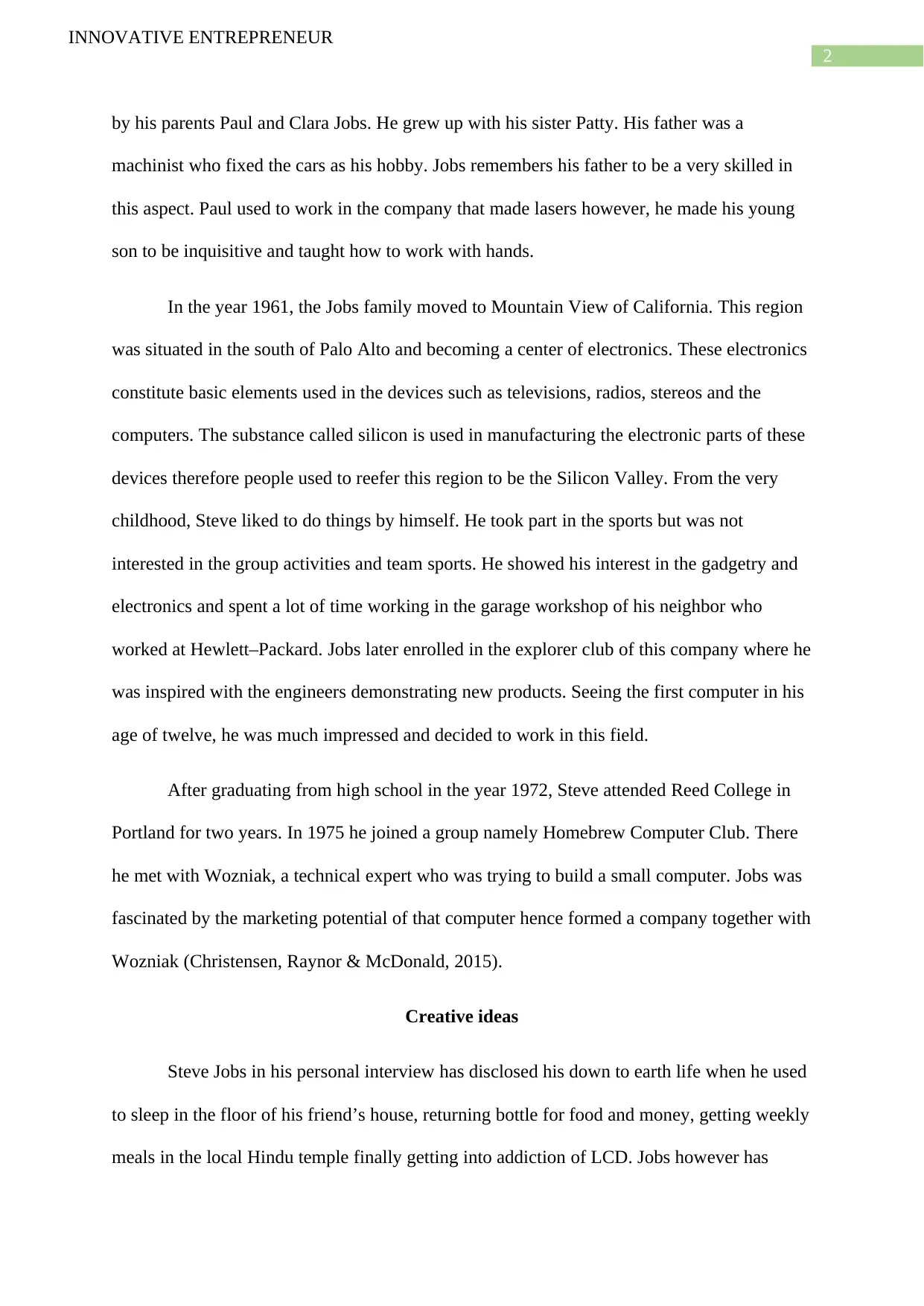
2
INNOVATIVE ENTREPRENEUR
by his parents Paul and Clara Jobs. He grew up with his sister Patty. His father was a
machinist who fixed the cars as his hobby. Jobs remembers his father to be a very skilled in
this aspect. Paul used to work in the company that made lasers however, he made his young
son to be inquisitive and taught how to work with hands.
In the year 1961, the Jobs family moved to Mountain View of California. This region
was situated in the south of Palo Alto and becoming a center of electronics. These electronics
constitute basic elements used in the devices such as televisions, radios, stereos and the
computers. The substance called silicon is used in manufacturing the electronic parts of these
devices therefore people used to reefer this region to be the Silicon Valley. From the very
childhood, Steve liked to do things by himself. He took part in the sports but was not
interested in the group activities and team sports. He showed his interest in the gadgetry and
electronics and spent a lot of time working in the garage workshop of his neighbor who
worked at Hewlett–Packard. Jobs later enrolled in the explorer club of this company where he
was inspired with the engineers demonstrating new products. Seeing the first computer in his
age of twelve, he was much impressed and decided to work in this field.
After graduating from high school in the year 1972, Steve attended Reed College in
Portland for two years. In 1975 he joined a group namely Homebrew Computer Club. There
he met with Wozniak, a technical expert who was trying to build a small computer. Jobs was
fascinated by the marketing potential of that computer hence formed a company together with
Wozniak (Christensen, Raynor & McDonald, 2015).
Creative ideas
Steve Jobs in his personal interview has disclosed his down to earth life when he used
to sleep in the floor of his friend’s house, returning bottle for food and money, getting weekly
meals in the local Hindu temple finally getting into addiction of LCD. Jobs however has
INNOVATIVE ENTREPRENEUR
by his parents Paul and Clara Jobs. He grew up with his sister Patty. His father was a
machinist who fixed the cars as his hobby. Jobs remembers his father to be a very skilled in
this aspect. Paul used to work in the company that made lasers however, he made his young
son to be inquisitive and taught how to work with hands.
In the year 1961, the Jobs family moved to Mountain View of California. This region
was situated in the south of Palo Alto and becoming a center of electronics. These electronics
constitute basic elements used in the devices such as televisions, radios, stereos and the
computers. The substance called silicon is used in manufacturing the electronic parts of these
devices therefore people used to reefer this region to be the Silicon Valley. From the very
childhood, Steve liked to do things by himself. He took part in the sports but was not
interested in the group activities and team sports. He showed his interest in the gadgetry and
electronics and spent a lot of time working in the garage workshop of his neighbor who
worked at Hewlett–Packard. Jobs later enrolled in the explorer club of this company where he
was inspired with the engineers demonstrating new products. Seeing the first computer in his
age of twelve, he was much impressed and decided to work in this field.
After graduating from high school in the year 1972, Steve attended Reed College in
Portland for two years. In 1975 he joined a group namely Homebrew Computer Club. There
he met with Wozniak, a technical expert who was trying to build a small computer. Jobs was
fascinated by the marketing potential of that computer hence formed a company together with
Wozniak (Christensen, Raynor & McDonald, 2015).
Creative ideas
Steve Jobs in his personal interview has disclosed his down to earth life when he used
to sleep in the floor of his friend’s house, returning bottle for food and money, getting weekly
meals in the local Hindu temple finally getting into addiction of LCD. Jobs however has

3
INNOVATIVE ENTREPRENEUR
called this drug experience to be the most enlightening experience of his life. Steve Jobs was
among the first who viewed the commercial potential of computer. This was the reason why
at the age of 21, he with Steve Wozniak founded their personal computer company and
invented the first Apple computer in his parent’s garage. Jobs realized that there was a great
gap in the computer market of the world. At that time, all the computers were mainframes
and large enough to fill a room. These were so costly that people from high Income group
could only afford to buy these computers. With the advancement of electronics, Jobs realized
that the components of these computers would be getting smaller but their power will be
increasing.
This is the reason, Wozniak and Jobs started to redesign their computers with the aim
to sell them top the individual users. During this time, they did not have much money to
spend in innovating in their field therefore funded their entrepreneurial venture by selling
their favorite thigs. Their company was called Apple Computer Company which was raised
with $1,300 by selling the calculator of Wozniak and micro bus of Steve Jobs. Initially they
used to sell circuit boards and then started were working on the prototype of computer (Sun et
al., 2016). Both Steve Jobs and Steve Wozniak are credited with revolutionizing the computer
industry by inventing Apple computers. Their creativity and imagination democratized the
computer technology and made these electronics smaller, intuitive, inexpensive and
accessible to the everyday customers. Wozniak conceived a series of personal user-friendly
computers and Jobs was in charge of marketing. In this, the company initially marketed its
products for $666.66 each. Apple I earned the corporation around $774,000 (Piao & Kleiner,
2015). In 1977 the Apple II was released in the market, its first year sales were of $2.7
million. Within three years, the company’s sales were increased by 700 percent, grew to $200
million. This was one of the most extraordinary cases of corporate growth in the history the
INNOVATIVE ENTREPRENEUR
called this drug experience to be the most enlightening experience of his life. Steve Jobs was
among the first who viewed the commercial potential of computer. This was the reason why
at the age of 21, he with Steve Wozniak founded their personal computer company and
invented the first Apple computer in his parent’s garage. Jobs realized that there was a great
gap in the computer market of the world. At that time, all the computers were mainframes
and large enough to fill a room. These were so costly that people from high Income group
could only afford to buy these computers. With the advancement of electronics, Jobs realized
that the components of these computers would be getting smaller but their power will be
increasing.
This is the reason, Wozniak and Jobs started to redesign their computers with the aim
to sell them top the individual users. During this time, they did not have much money to
spend in innovating in their field therefore funded their entrepreneurial venture by selling
their favorite thigs. Their company was called Apple Computer Company which was raised
with $1,300 by selling the calculator of Wozniak and micro bus of Steve Jobs. Initially they
used to sell circuit boards and then started were working on the prototype of computer (Sun et
al., 2016). Both Steve Jobs and Steve Wozniak are credited with revolutionizing the computer
industry by inventing Apple computers. Their creativity and imagination democratized the
computer technology and made these electronics smaller, intuitive, inexpensive and
accessible to the everyday customers. Wozniak conceived a series of personal user-friendly
computers and Jobs was in charge of marketing. In this, the company initially marketed its
products for $666.66 each. Apple I earned the corporation around $774,000 (Piao & Kleiner,
2015). In 1977 the Apple II was released in the market, its first year sales were of $2.7
million. Within three years, the company’s sales were increased by 700 percent, grew to $200
million. This was one of the most extraordinary cases of corporate growth in the history the
Secure Best Marks with AI Grader
Need help grading? Try our AI Grader for instant feedback on your assignments.
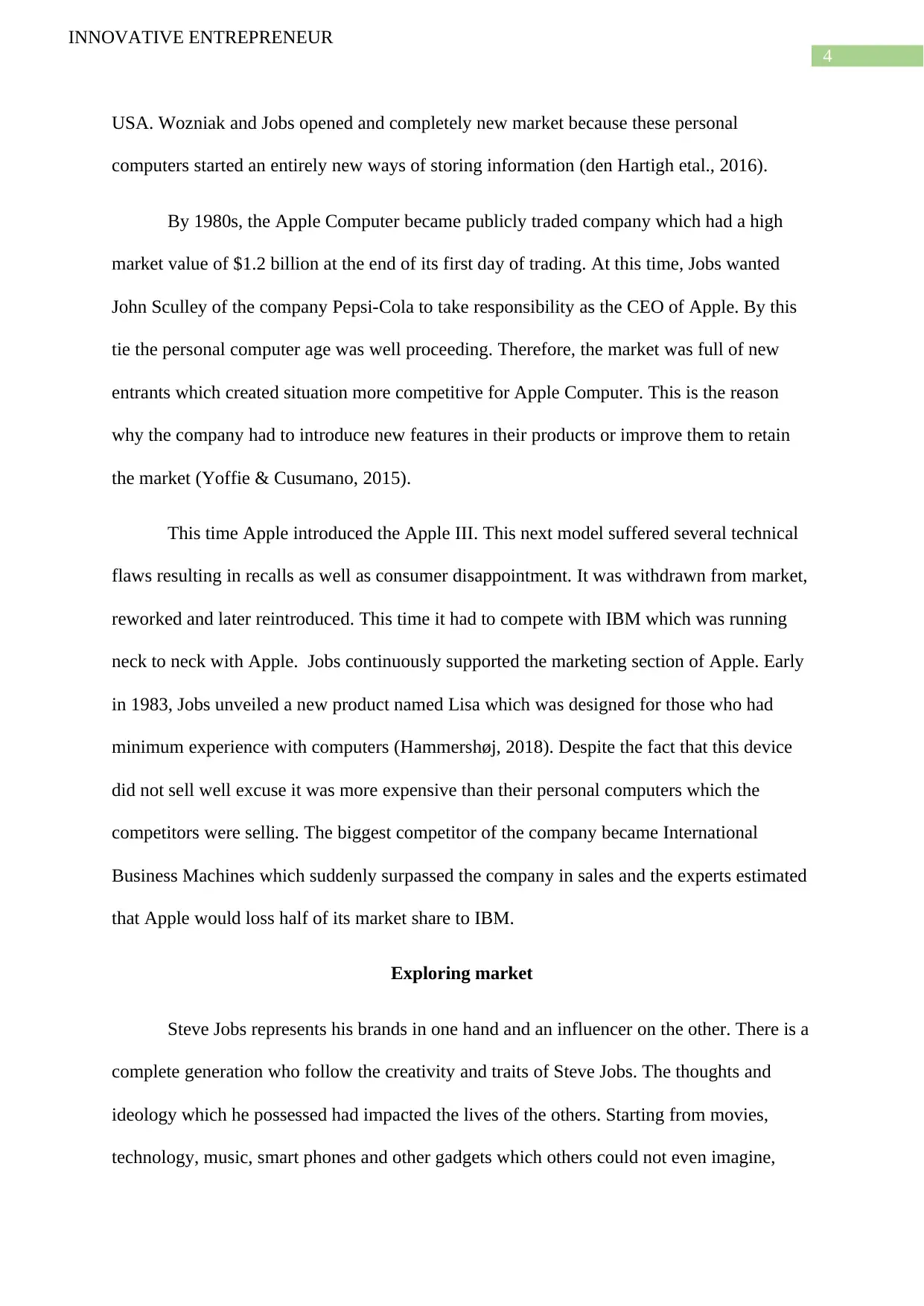
4
INNOVATIVE ENTREPRENEUR
USA. Wozniak and Jobs opened and completely new market because these personal
computers started an entirely new ways of storing information (den Hartigh etal., 2016).
By 1980s, the Apple Computer became publicly traded company which had a high
market value of $1.2 billion at the end of its first day of trading. At this time, Jobs wanted
John Sculley of the company Pepsi-Cola to take responsibility as the CEO of Apple. By this
tie the personal computer age was well proceeding. Therefore, the market was full of new
entrants which created situation more competitive for Apple Computer. This is the reason
why the company had to introduce new features in their products or improve them to retain
the market (Yoffie & Cusumano, 2015).
This time Apple introduced the Apple III. This next model suffered several technical
flaws resulting in recalls as well as consumer disappointment. It was withdrawn from market,
reworked and later reintroduced. This time it had to compete with IBM which was running
neck to neck with Apple. Jobs continuously supported the marketing section of Apple. Early
in 1983, Jobs unveiled a new product named Lisa which was designed for those who had
minimum experience with computers (Hammershøj, 2018). Despite the fact that this device
did not sell well excuse it was more expensive than their personal computers which the
competitors were selling. The biggest competitor of the company became International
Business Machines which suddenly surpassed the company in sales and the experts estimated
that Apple would loss half of its market share to IBM.
Exploring market
Steve Jobs represents his brands in one hand and an influencer on the other. There is a
complete generation who follow the creativity and traits of Steve Jobs. The thoughts and
ideology which he possessed had impacted the lives of the others. Starting from movies,
technology, music, smart phones and other gadgets which others could not even imagine,
INNOVATIVE ENTREPRENEUR
USA. Wozniak and Jobs opened and completely new market because these personal
computers started an entirely new ways of storing information (den Hartigh etal., 2016).
By 1980s, the Apple Computer became publicly traded company which had a high
market value of $1.2 billion at the end of its first day of trading. At this time, Jobs wanted
John Sculley of the company Pepsi-Cola to take responsibility as the CEO of Apple. By this
tie the personal computer age was well proceeding. Therefore, the market was full of new
entrants which created situation more competitive for Apple Computer. This is the reason
why the company had to introduce new features in their products or improve them to retain
the market (Yoffie & Cusumano, 2015).
This time Apple introduced the Apple III. This next model suffered several technical
flaws resulting in recalls as well as consumer disappointment. It was withdrawn from market,
reworked and later reintroduced. This time it had to compete with IBM which was running
neck to neck with Apple. Jobs continuously supported the marketing section of Apple. Early
in 1983, Jobs unveiled a new product named Lisa which was designed for those who had
minimum experience with computers (Hammershøj, 2018). Despite the fact that this device
did not sell well excuse it was more expensive than their personal computers which the
competitors were selling. The biggest competitor of the company became International
Business Machines which suddenly surpassed the company in sales and the experts estimated
that Apple would loss half of its market share to IBM.
Exploring market
Steve Jobs represents his brands in one hand and an influencer on the other. There is a
complete generation who follow the creativity and traits of Steve Jobs. The thoughts and
ideology which he possessed had impacted the lives of the others. Starting from movies,
technology, music, smart phones and other gadgets which others could not even imagine,
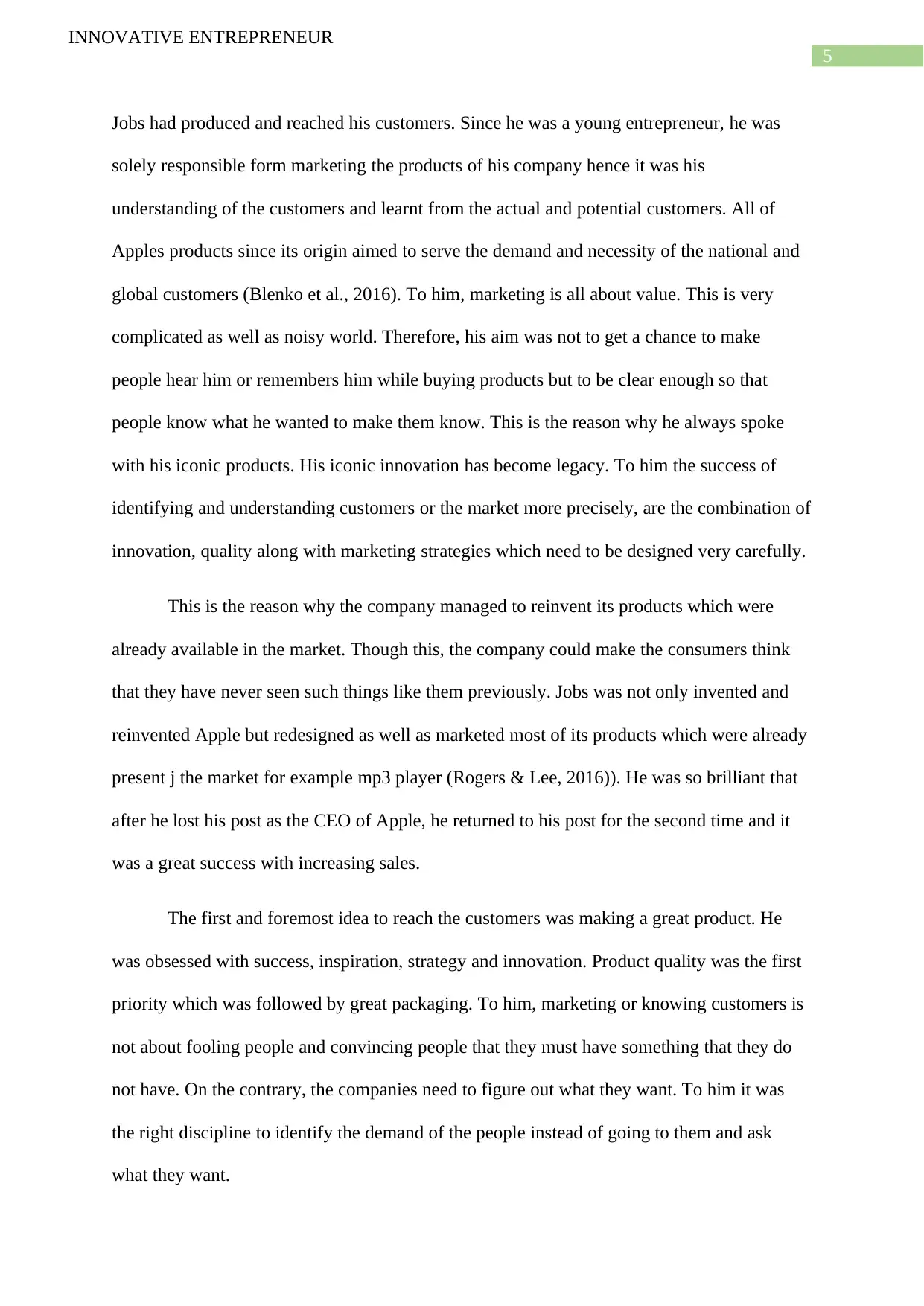
5
INNOVATIVE ENTREPRENEUR
Jobs had produced and reached his customers. Since he was a young entrepreneur, he was
solely responsible form marketing the products of his company hence it was his
understanding of the customers and learnt from the actual and potential customers. All of
Apples products since its origin aimed to serve the demand and necessity of the national and
global customers (Blenko et al., 2016). To him, marketing is all about value. This is very
complicated as well as noisy world. Therefore, his aim was not to get a chance to make
people hear him or remembers him while buying products but to be clear enough so that
people know what he wanted to make them know. This is the reason why he always spoke
with his iconic products. His iconic innovation has become legacy. To him the success of
identifying and understanding customers or the market more precisely, are the combination of
innovation, quality along with marketing strategies which need to be designed very carefully.
This is the reason why the company managed to reinvent its products which were
already available in the market. Though this, the company could make the consumers think
that they have never seen such things like them previously. Jobs was not only invented and
reinvented Apple but redesigned as well as marketed most of its products which were already
present j the market for example mp3 player (Rogers & Lee, 2016)). He was so brilliant that
after he lost his post as the CEO of Apple, he returned to his post for the second time and it
was a great success with increasing sales.
The first and foremost idea to reach the customers was making a great product. He
was obsessed with success, inspiration, strategy and innovation. Product quality was the first
priority which was followed by great packaging. To him, marketing or knowing customers is
not about fooling people and convincing people that they must have something that they do
not have. On the contrary, the companies need to figure out what they want. To him it was
the right discipline to identify the demand of the people instead of going to them and ask
what they want.
INNOVATIVE ENTREPRENEUR
Jobs had produced and reached his customers. Since he was a young entrepreneur, he was
solely responsible form marketing the products of his company hence it was his
understanding of the customers and learnt from the actual and potential customers. All of
Apples products since its origin aimed to serve the demand and necessity of the national and
global customers (Blenko et al., 2016). To him, marketing is all about value. This is very
complicated as well as noisy world. Therefore, his aim was not to get a chance to make
people hear him or remembers him while buying products but to be clear enough so that
people know what he wanted to make them know. This is the reason why he always spoke
with his iconic products. His iconic innovation has become legacy. To him the success of
identifying and understanding customers or the market more precisely, are the combination of
innovation, quality along with marketing strategies which need to be designed very carefully.
This is the reason why the company managed to reinvent its products which were
already available in the market. Though this, the company could make the consumers think
that they have never seen such things like them previously. Jobs was not only invented and
reinvented Apple but redesigned as well as marketed most of its products which were already
present j the market for example mp3 player (Rogers & Lee, 2016)). He was so brilliant that
after he lost his post as the CEO of Apple, he returned to his post for the second time and it
was a great success with increasing sales.
The first and foremost idea to reach the customers was making a great product. He
was obsessed with success, inspiration, strategy and innovation. Product quality was the first
priority which was followed by great packaging. To him, marketing or knowing customers is
not about fooling people and convincing people that they must have something that they do
not have. On the contrary, the companies need to figure out what they want. To him it was
the right discipline to identify the demand of the people instead of going to them and ask
what they want.
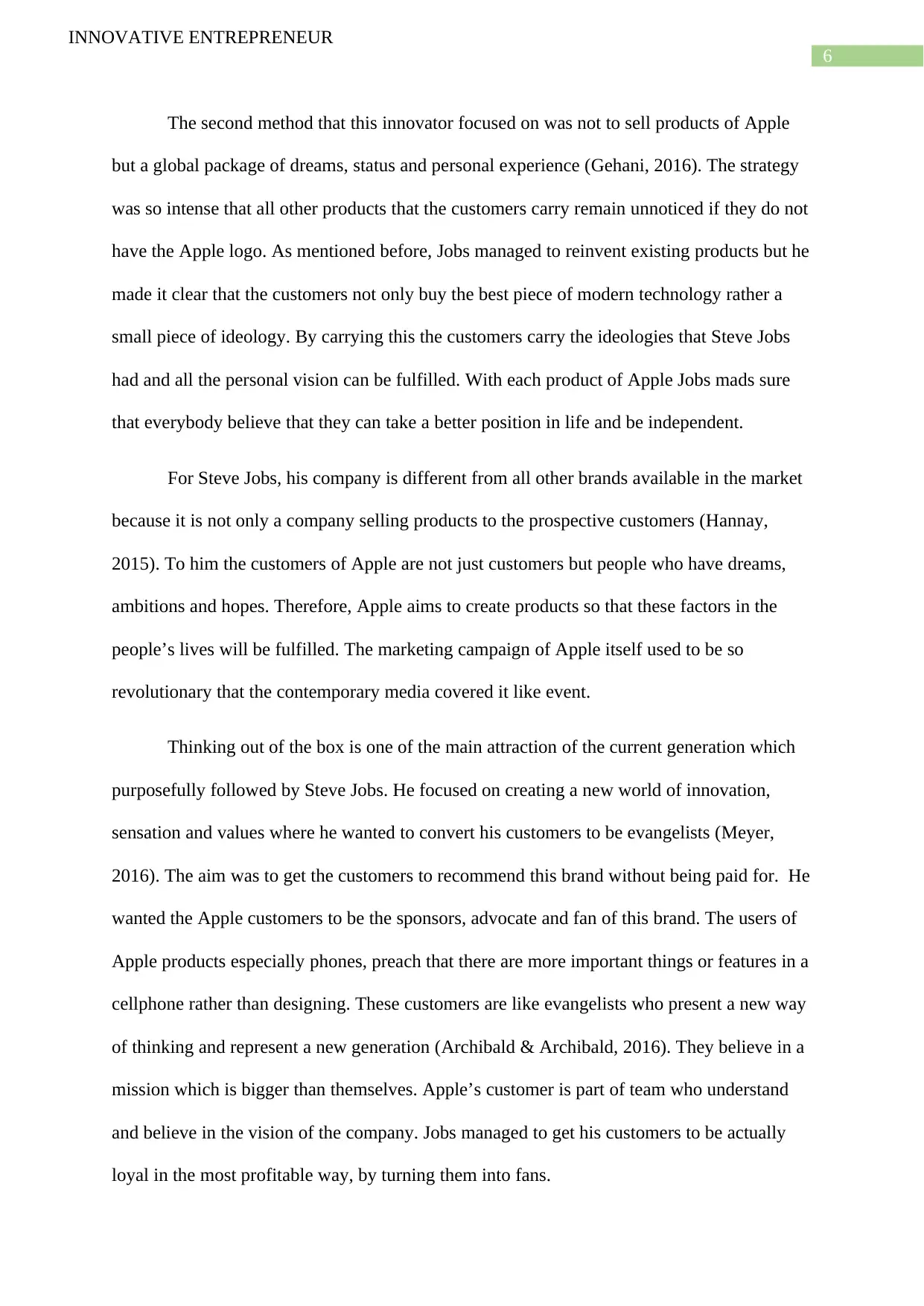
6
INNOVATIVE ENTREPRENEUR
The second method that this innovator focused on was not to sell products of Apple
but a global package of dreams, status and personal experience (Gehani, 2016). The strategy
was so intense that all other products that the customers carry remain unnoticed if they do not
have the Apple logo. As mentioned before, Jobs managed to reinvent existing products but he
made it clear that the customers not only buy the best piece of modern technology rather a
small piece of ideology. By carrying this the customers carry the ideologies that Steve Jobs
had and all the personal vision can be fulfilled. With each product of Apple Jobs mads sure
that everybody believe that they can take a better position in life and be independent.
For Steve Jobs, his company is different from all other brands available in the market
because it is not only a company selling products to the prospective customers (Hannay,
2015). To him the customers of Apple are not just customers but people who have dreams,
ambitions and hopes. Therefore, Apple aims to create products so that these factors in the
people’s lives will be fulfilled. The marketing campaign of Apple itself used to be so
revolutionary that the contemporary media covered it like event.
Thinking out of the box is one of the main attraction of the current generation which
purposefully followed by Steve Jobs. He focused on creating a new world of innovation,
sensation and values where he wanted to convert his customers to be evangelists (Meyer,
2016). The aim was to get the customers to recommend this brand without being paid for. He
wanted the Apple customers to be the sponsors, advocate and fan of this brand. The users of
Apple products especially phones, preach that there are more important things or features in a
cellphone rather than designing. These customers are like evangelists who present a new way
of thinking and represent a new generation (Archibald & Archibald, 2016). They believe in a
mission which is bigger than themselves. Apple’s customer is part of team who understand
and believe in the vision of the company. Jobs managed to get his customers to be actually
loyal in the most profitable way, by turning them into fans.
INNOVATIVE ENTREPRENEUR
The second method that this innovator focused on was not to sell products of Apple
but a global package of dreams, status and personal experience (Gehani, 2016). The strategy
was so intense that all other products that the customers carry remain unnoticed if they do not
have the Apple logo. As mentioned before, Jobs managed to reinvent existing products but he
made it clear that the customers not only buy the best piece of modern technology rather a
small piece of ideology. By carrying this the customers carry the ideologies that Steve Jobs
had and all the personal vision can be fulfilled. With each product of Apple Jobs mads sure
that everybody believe that they can take a better position in life and be independent.
For Steve Jobs, his company is different from all other brands available in the market
because it is not only a company selling products to the prospective customers (Hannay,
2015). To him the customers of Apple are not just customers but people who have dreams,
ambitions and hopes. Therefore, Apple aims to create products so that these factors in the
people’s lives will be fulfilled. The marketing campaign of Apple itself used to be so
revolutionary that the contemporary media covered it like event.
Thinking out of the box is one of the main attraction of the current generation which
purposefully followed by Steve Jobs. He focused on creating a new world of innovation,
sensation and values where he wanted to convert his customers to be evangelists (Meyer,
2016). The aim was to get the customers to recommend this brand without being paid for. He
wanted the Apple customers to be the sponsors, advocate and fan of this brand. The users of
Apple products especially phones, preach that there are more important things or features in a
cellphone rather than designing. These customers are like evangelists who present a new way
of thinking and represent a new generation (Archibald & Archibald, 2016). They believe in a
mission which is bigger than themselves. Apple’s customer is part of team who understand
and believe in the vision of the company. Jobs managed to get his customers to be actually
loyal in the most profitable way, by turning them into fans.
Paraphrase This Document
Need a fresh take? Get an instant paraphrase of this document with our AI Paraphraser
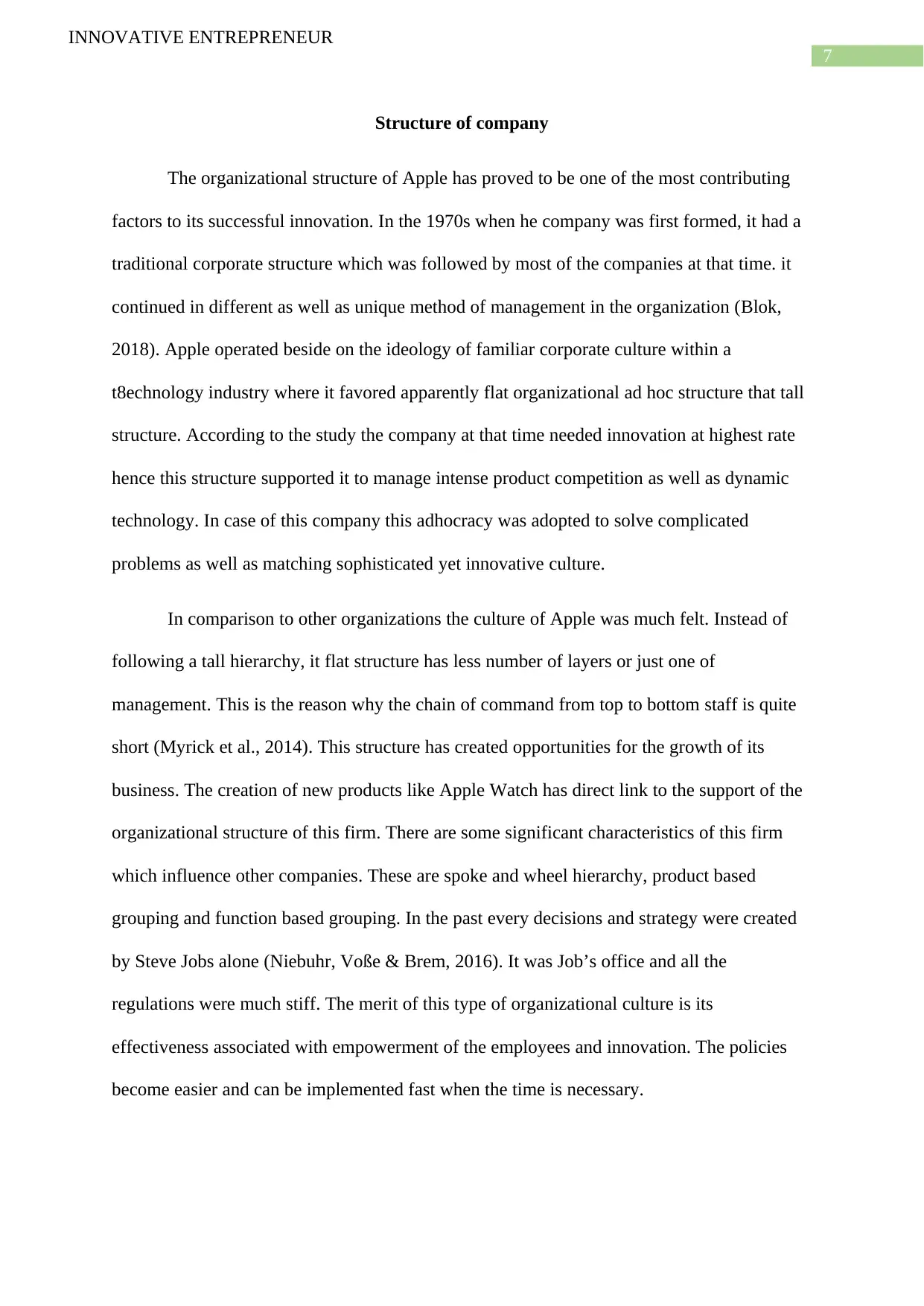
7
INNOVATIVE ENTREPRENEUR
Structure of company
The organizational structure of Apple has proved to be one of the most contributing
factors to its successful innovation. In the 1970s when he company was first formed, it had a
traditional corporate structure which was followed by most of the companies at that time. it
continued in different as well as unique method of management in the organization (Blok,
2018). Apple operated beside on the ideology of familiar corporate culture within a
t8echnology industry where it favored apparently flat organizational ad hoc structure that tall
structure. According to the study the company at that time needed innovation at highest rate
hence this structure supported it to manage intense product competition as well as dynamic
technology. In case of this company this adhocracy was adopted to solve complicated
problems as well as matching sophisticated yet innovative culture.
In comparison to other organizations the culture of Apple was much felt. Instead of
following a tall hierarchy, it flat structure has less number of layers or just one of
management. This is the reason why the chain of command from top to bottom staff is quite
short (Myrick et al., 2014). This structure has created opportunities for the growth of its
business. The creation of new products like Apple Watch has direct link to the support of the
organizational structure of this firm. There are some significant characteristics of this firm
which influence other companies. These are spoke and wheel hierarchy, product based
grouping and function based grouping. In the past every decisions and strategy were created
by Steve Jobs alone (Niebuhr, Voße & Brem, 2016). It was Job’s office and all the
regulations were much stiff. The merit of this type of organizational culture is its
effectiveness associated with empowerment of the employees and innovation. The policies
become easier and can be implemented fast when the time is necessary.
INNOVATIVE ENTREPRENEUR
Structure of company
The organizational structure of Apple has proved to be one of the most contributing
factors to its successful innovation. In the 1970s when he company was first formed, it had a
traditional corporate structure which was followed by most of the companies at that time. it
continued in different as well as unique method of management in the organization (Blok,
2018). Apple operated beside on the ideology of familiar corporate culture within a
t8echnology industry where it favored apparently flat organizational ad hoc structure that tall
structure. According to the study the company at that time needed innovation at highest rate
hence this structure supported it to manage intense product competition as well as dynamic
technology. In case of this company this adhocracy was adopted to solve complicated
problems as well as matching sophisticated yet innovative culture.
In comparison to other organizations the culture of Apple was much felt. Instead of
following a tall hierarchy, it flat structure has less number of layers or just one of
management. This is the reason why the chain of command from top to bottom staff is quite
short (Myrick et al., 2014). This structure has created opportunities for the growth of its
business. The creation of new products like Apple Watch has direct link to the support of the
organizational structure of this firm. There are some significant characteristics of this firm
which influence other companies. These are spoke and wheel hierarchy, product based
grouping and function based grouping. In the past every decisions and strategy were created
by Steve Jobs alone (Niebuhr, Voße & Brem, 2016). It was Job’s office and all the
regulations were much stiff. The merit of this type of organizational culture is its
effectiveness associated with empowerment of the employees and innovation. The policies
become easier and can be implemented fast when the time is necessary.
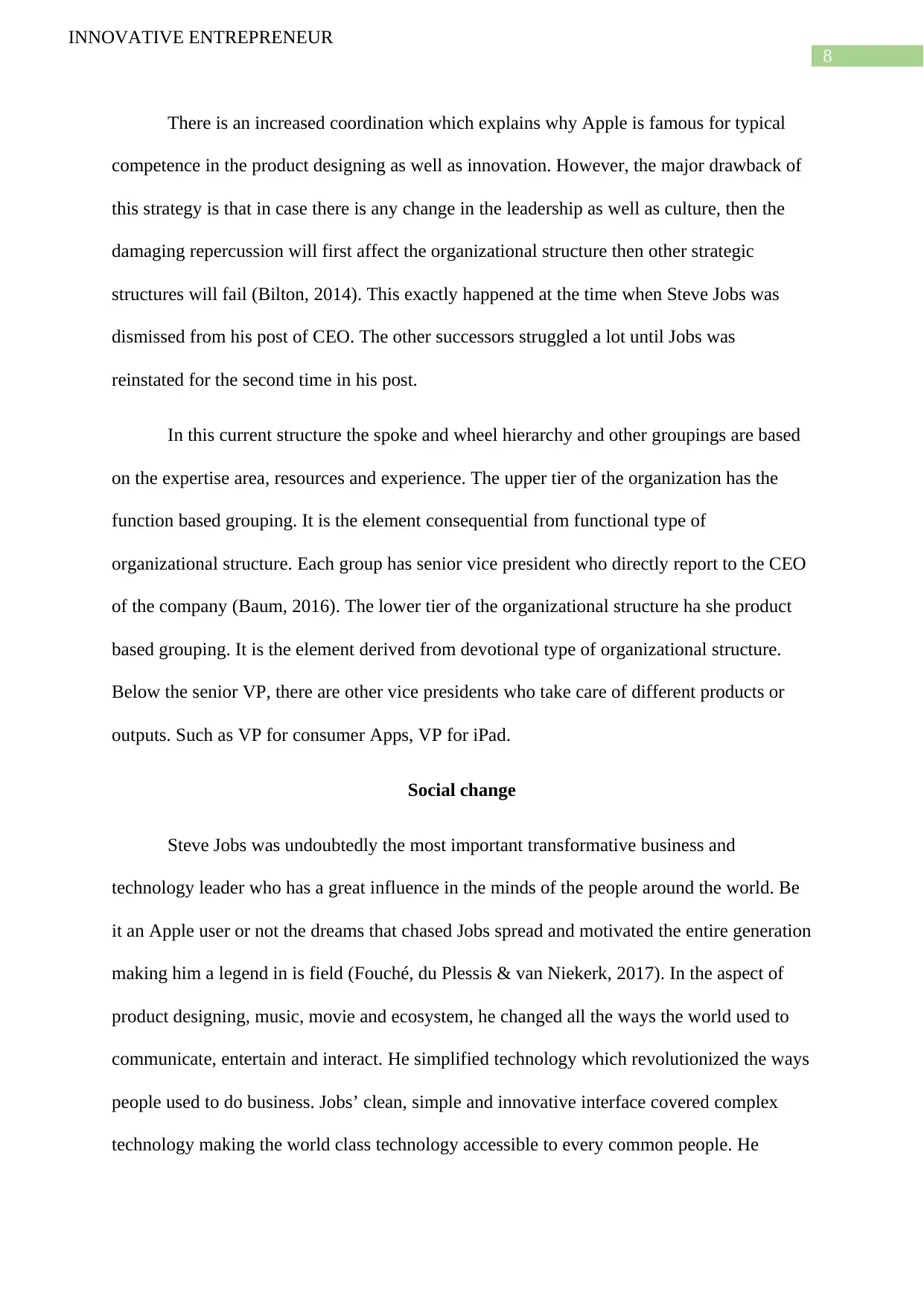
8
INNOVATIVE ENTREPRENEUR
There is an increased coordination which explains why Apple is famous for typical
competence in the product designing as well as innovation. However, the major drawback of
this strategy is that in case there is any change in the leadership as well as culture, then the
damaging repercussion will first affect the organizational structure then other strategic
structures will fail (Bilton, 2014). This exactly happened at the time when Steve Jobs was
dismissed from his post of CEO. The other successors struggled a lot until Jobs was
reinstated for the second time in his post.
In this current structure the spoke and wheel hierarchy and other groupings are based
on the expertise area, resources and experience. The upper tier of the organization has the
function based grouping. It is the element consequential from functional type of
organizational structure. Each group has senior vice president who directly report to the CEO
of the company (Baum, 2016). The lower tier of the organizational structure ha she product
based grouping. It is the element derived from devotional type of organizational structure.
Below the senior VP, there are other vice presidents who take care of different products or
outputs. Such as VP for consumer Apps, VP for iPad.
Social change
Steve Jobs was undoubtedly the most important transformative business and
technology leader who has a great influence in the minds of the people around the world. Be
it an Apple user or not the dreams that chased Jobs spread and motivated the entire generation
making him a legend in is field (Fouché, du Plessis & van Niekerk, 2017). In the aspect of
product designing, music, movie and ecosystem, he changed all the ways the world used to
communicate, entertain and interact. He simplified technology which revolutionized the ways
people used to do business. Jobs’ clean, simple and innovative interface covered complex
technology making the world class technology accessible to every common people. He
INNOVATIVE ENTREPRENEUR
There is an increased coordination which explains why Apple is famous for typical
competence in the product designing as well as innovation. However, the major drawback of
this strategy is that in case there is any change in the leadership as well as culture, then the
damaging repercussion will first affect the organizational structure then other strategic
structures will fail (Bilton, 2014). This exactly happened at the time when Steve Jobs was
dismissed from his post of CEO. The other successors struggled a lot until Jobs was
reinstated for the second time in his post.
In this current structure the spoke and wheel hierarchy and other groupings are based
on the expertise area, resources and experience. The upper tier of the organization has the
function based grouping. It is the element consequential from functional type of
organizational structure. Each group has senior vice president who directly report to the CEO
of the company (Baum, 2016). The lower tier of the organizational structure ha she product
based grouping. It is the element derived from devotional type of organizational structure.
Below the senior VP, there are other vice presidents who take care of different products or
outputs. Such as VP for consumer Apps, VP for iPad.
Social change
Steve Jobs was undoubtedly the most important transformative business and
technology leader who has a great influence in the minds of the people around the world. Be
it an Apple user or not the dreams that chased Jobs spread and motivated the entire generation
making him a legend in is field (Fouché, du Plessis & van Niekerk, 2017). In the aspect of
product designing, music, movie and ecosystem, he changed all the ways the world used to
communicate, entertain and interact. He simplified technology which revolutionized the ways
people used to do business. Jobs’ clean, simple and innovative interface covered complex
technology making the world class technology accessible to every common people. He
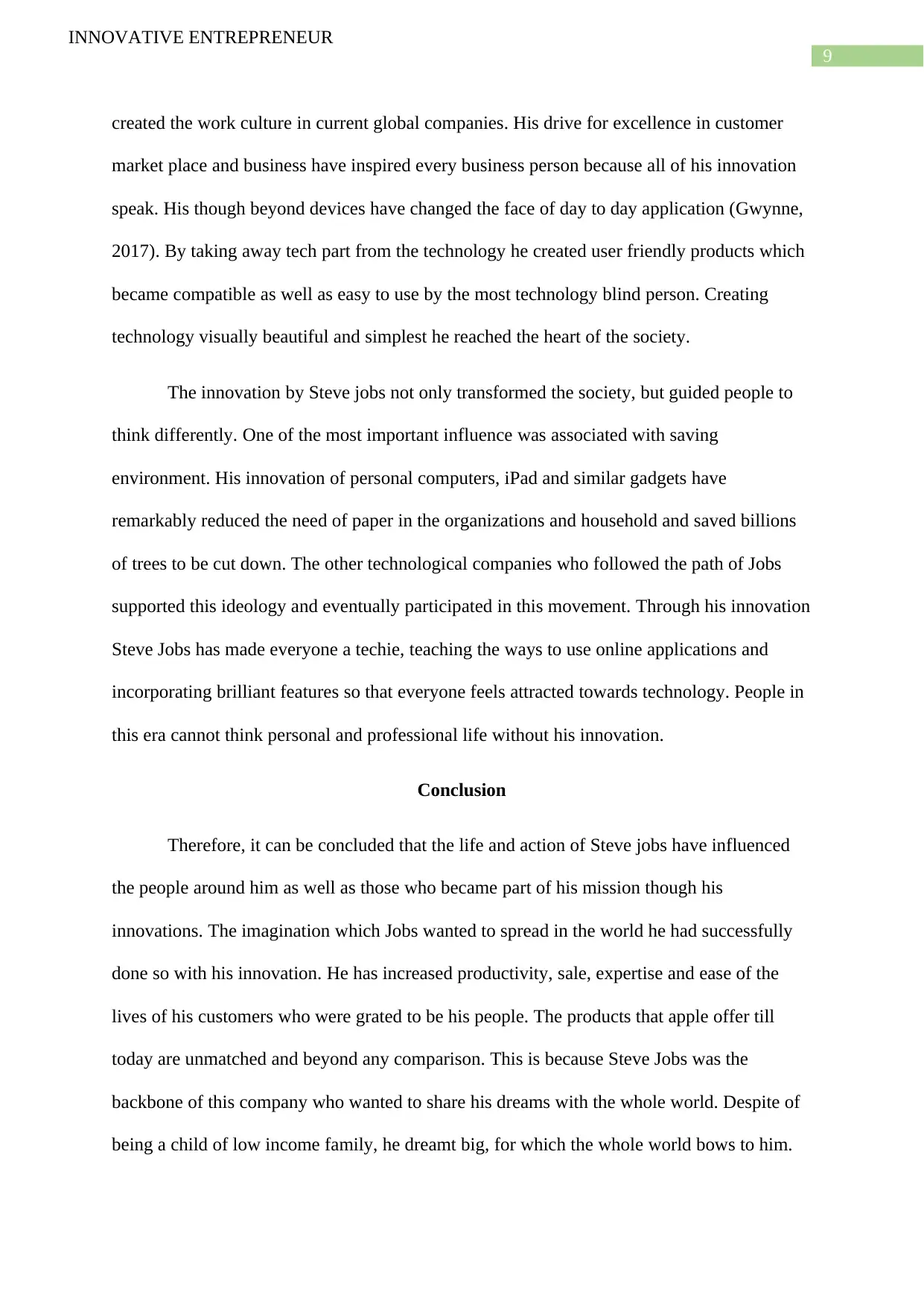
9
INNOVATIVE ENTREPRENEUR
created the work culture in current global companies. His drive for excellence in customer
market place and business have inspired every business person because all of his innovation
speak. His though beyond devices have changed the face of day to day application (Gwynne,
2017). By taking away tech part from the technology he created user friendly products which
became compatible as well as easy to use by the most technology blind person. Creating
technology visually beautiful and simplest he reached the heart of the society.
The innovation by Steve jobs not only transformed the society, but guided people to
think differently. One of the most important influence was associated with saving
environment. His innovation of personal computers, iPad and similar gadgets have
remarkably reduced the need of paper in the organizations and household and saved billions
of trees to be cut down. The other technological companies who followed the path of Jobs
supported this ideology and eventually participated in this movement. Through his innovation
Steve Jobs has made everyone a techie, teaching the ways to use online applications and
incorporating brilliant features so that everyone feels attracted towards technology. People in
this era cannot think personal and professional life without his innovation.
Conclusion
Therefore, it can be concluded that the life and action of Steve jobs have influenced
the people around him as well as those who became part of his mission though his
innovations. The imagination which Jobs wanted to spread in the world he had successfully
done so with his innovation. He has increased productivity, sale, expertise and ease of the
lives of his customers who were grated to be his people. The products that apple offer till
today are unmatched and beyond any comparison. This is because Steve Jobs was the
backbone of this company who wanted to share his dreams with the whole world. Despite of
being a child of low income family, he dreamt big, for which the whole world bows to him.
INNOVATIVE ENTREPRENEUR
created the work culture in current global companies. His drive for excellence in customer
market place and business have inspired every business person because all of his innovation
speak. His though beyond devices have changed the face of day to day application (Gwynne,
2017). By taking away tech part from the technology he created user friendly products which
became compatible as well as easy to use by the most technology blind person. Creating
technology visually beautiful and simplest he reached the heart of the society.
The innovation by Steve jobs not only transformed the society, but guided people to
think differently. One of the most important influence was associated with saving
environment. His innovation of personal computers, iPad and similar gadgets have
remarkably reduced the need of paper in the organizations and household and saved billions
of trees to be cut down. The other technological companies who followed the path of Jobs
supported this ideology and eventually participated in this movement. Through his innovation
Steve Jobs has made everyone a techie, teaching the ways to use online applications and
incorporating brilliant features so that everyone feels attracted towards technology. People in
this era cannot think personal and professional life without his innovation.
Conclusion
Therefore, it can be concluded that the life and action of Steve jobs have influenced
the people around him as well as those who became part of his mission though his
innovations. The imagination which Jobs wanted to spread in the world he had successfully
done so with his innovation. He has increased productivity, sale, expertise and ease of the
lives of his customers who were grated to be his people. The products that apple offer till
today are unmatched and beyond any comparison. This is because Steve Jobs was the
backbone of this company who wanted to share his dreams with the whole world. Despite of
being a child of low income family, he dreamt big, for which the whole world bows to him.
Secure Best Marks with AI Grader
Need help grading? Try our AI Grader for instant feedback on your assignments.
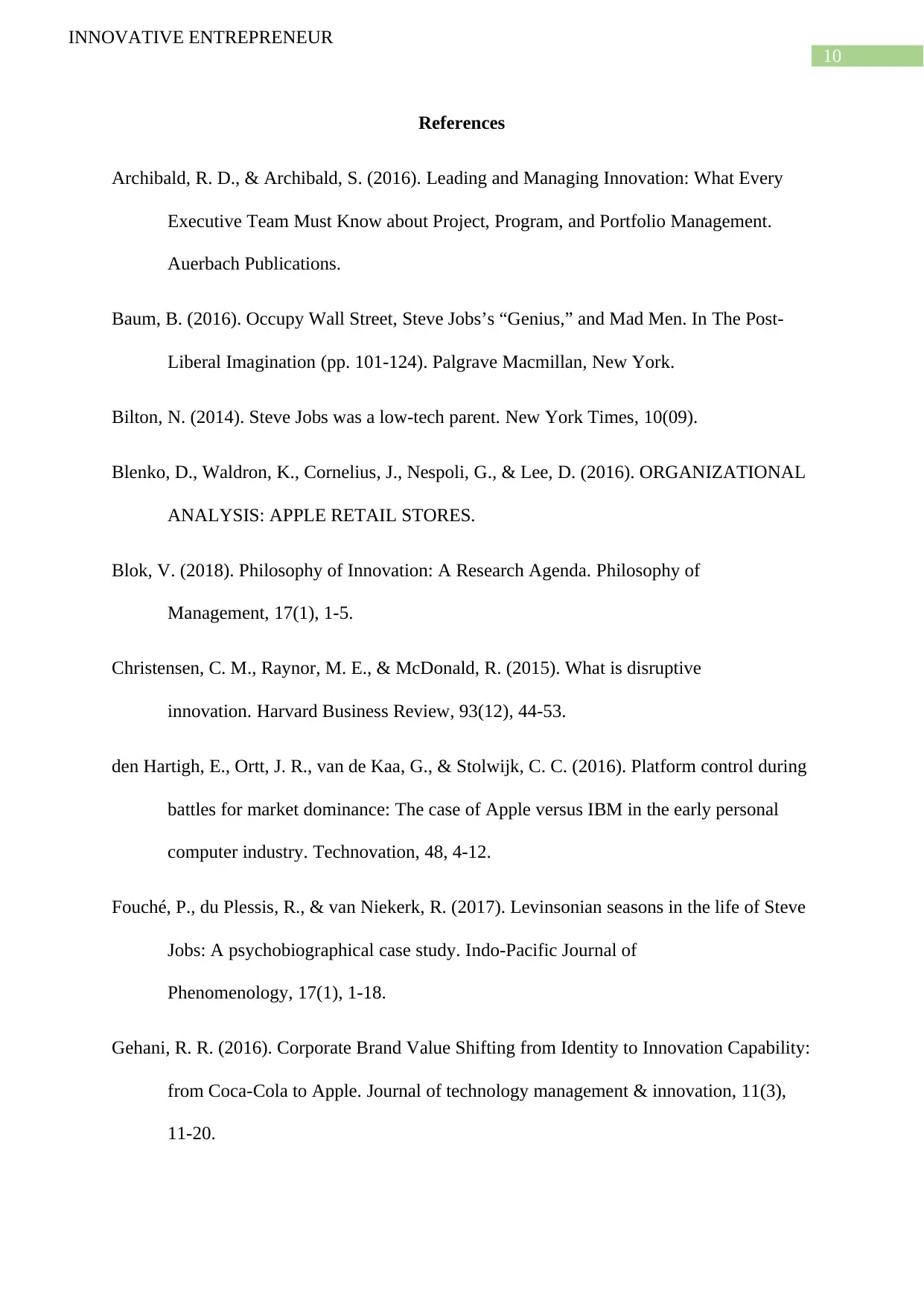
10
INNOVATIVE ENTREPRENEUR
References
Archibald, R. D., & Archibald, S. (2016). Leading and Managing Innovation: What Every
Executive Team Must Know about Project, Program, and Portfolio Management.
Auerbach Publications.
Baum, B. (2016). Occupy Wall Street, Steve Jobs’s “Genius,” and Mad Men. In The Post-
Liberal Imagination (pp. 101-124). Palgrave Macmillan, New York.
Bilton, N. (2014). Steve Jobs was a low-tech parent. New York Times, 10(09).
Blenko, D., Waldron, K., Cornelius, J., Nespoli, G., & Lee, D. (2016). ORGANIZATIONAL
ANALYSIS: APPLE RETAIL STORES.
Blok, V. (2018). Philosophy of Innovation: A Research Agenda. Philosophy of
Management, 17(1), 1-5.
Christensen, C. M., Raynor, M. E., & McDonald, R. (2015). What is disruptive
innovation. Harvard Business Review, 93(12), 44-53.
den Hartigh, E., Ortt, J. R., van de Kaa, G., & Stolwijk, C. C. (2016). Platform control during
battles for market dominance: The case of Apple versus IBM in the early personal
computer industry. Technovation, 48, 4-12.
Fouché, P., du Plessis, R., & van Niekerk, R. (2017). Levinsonian seasons in the life of Steve
Jobs: A psychobiographical case study. Indo-Pacific Journal of
Phenomenology, 17(1), 1-18.
Gehani, R. R. (2016). Corporate Brand Value Shifting from Identity to Innovation Capability:
from Coca-Cola to Apple. Journal of technology management & innovation, 11(3),
11-20.
INNOVATIVE ENTREPRENEUR
References
Archibald, R. D., & Archibald, S. (2016). Leading and Managing Innovation: What Every
Executive Team Must Know about Project, Program, and Portfolio Management.
Auerbach Publications.
Baum, B. (2016). Occupy Wall Street, Steve Jobs’s “Genius,” and Mad Men. In The Post-
Liberal Imagination (pp. 101-124). Palgrave Macmillan, New York.
Bilton, N. (2014). Steve Jobs was a low-tech parent. New York Times, 10(09).
Blenko, D., Waldron, K., Cornelius, J., Nespoli, G., & Lee, D. (2016). ORGANIZATIONAL
ANALYSIS: APPLE RETAIL STORES.
Blok, V. (2018). Philosophy of Innovation: A Research Agenda. Philosophy of
Management, 17(1), 1-5.
Christensen, C. M., Raynor, M. E., & McDonald, R. (2015). What is disruptive
innovation. Harvard Business Review, 93(12), 44-53.
den Hartigh, E., Ortt, J. R., van de Kaa, G., & Stolwijk, C. C. (2016). Platform control during
battles for market dominance: The case of Apple versus IBM in the early personal
computer industry. Technovation, 48, 4-12.
Fouché, P., du Plessis, R., & van Niekerk, R. (2017). Levinsonian seasons in the life of Steve
Jobs: A psychobiographical case study. Indo-Pacific Journal of
Phenomenology, 17(1), 1-18.
Gehani, R. R. (2016). Corporate Brand Value Shifting from Identity to Innovation Capability:
from Coca-Cola to Apple. Journal of technology management & innovation, 11(3),
11-20.
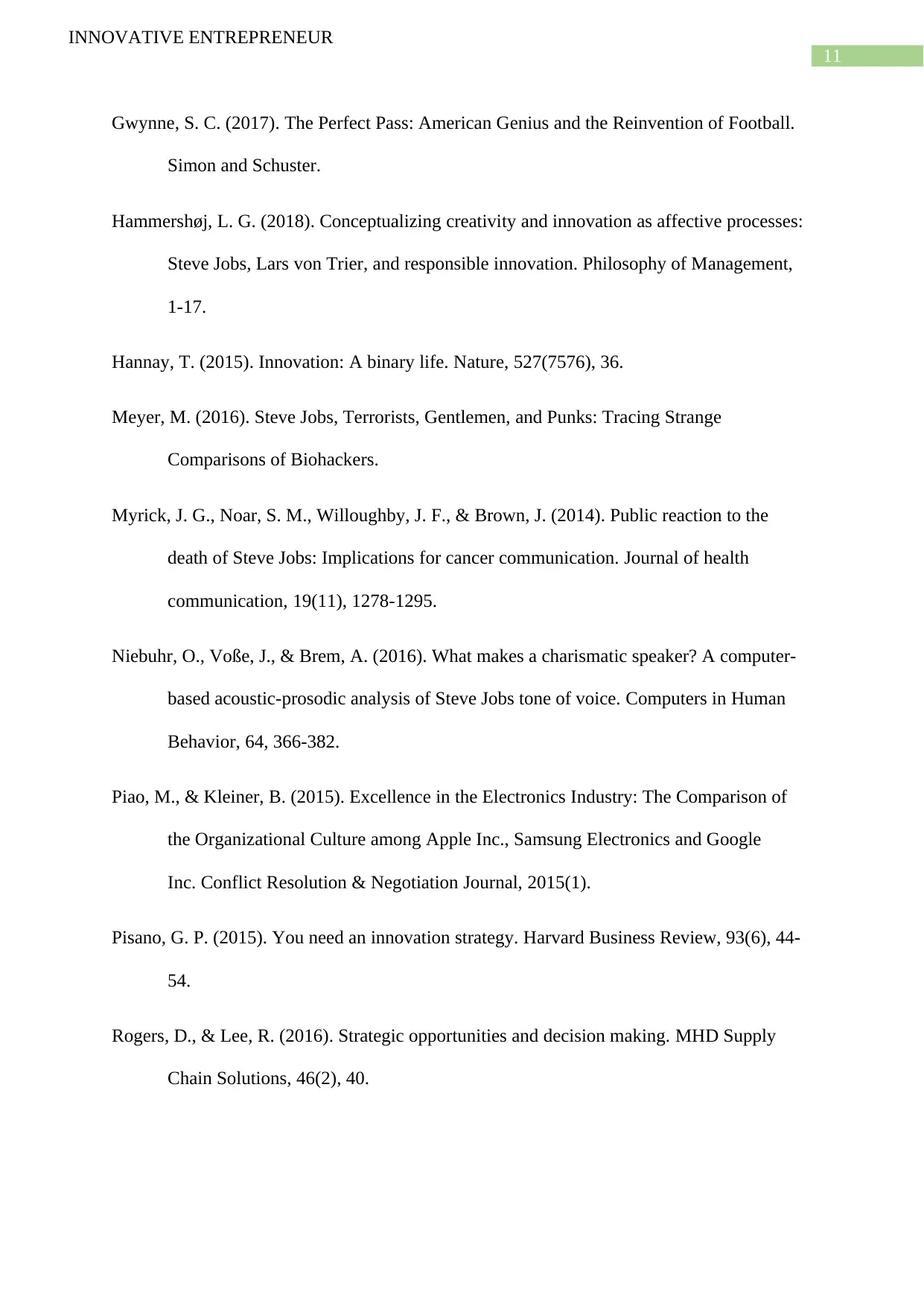
11
INNOVATIVE ENTREPRENEUR
Gwynne, S. C. (2017). The Perfect Pass: American Genius and the Reinvention of Football.
Simon and Schuster.
Hammershøj, L. G. (2018). Conceptualizing creativity and innovation as affective processes:
Steve Jobs, Lars von Trier, and responsible innovation. Philosophy of Management,
1-17.
Hannay, T. (2015). Innovation: A binary life. Nature, 527(7576), 36.
Meyer, M. (2016). Steve Jobs, Terrorists, Gentlemen, and Punks: Tracing Strange
Comparisons of Biohackers.
Myrick, J. G., Noar, S. M., Willoughby, J. F., & Brown, J. (2014). Public reaction to the
death of Steve Jobs: Implications for cancer communication. Journal of health
communication, 19(11), 1278-1295.
Niebuhr, O., Voße, J., & Brem, A. (2016). What makes a charismatic speaker? A computer-
based acoustic-prosodic analysis of Steve Jobs tone of voice. Computers in Human
Behavior, 64, 366-382.
Piao, M., & Kleiner, B. (2015). Excellence in the Electronics Industry: The Comparison of
the Organizational Culture among Apple Inc., Samsung Electronics and Google
Inc. Conflict Resolution & Negotiation Journal, 2015(1).
Pisano, G. P. (2015). You need an innovation strategy. Harvard Business Review, 93(6), 44-
54.
Rogers, D., & Lee, R. (2016). Strategic opportunities and decision making. MHD Supply
Chain Solutions, 46(2), 40.
INNOVATIVE ENTREPRENEUR
Gwynne, S. C. (2017). The Perfect Pass: American Genius and the Reinvention of Football.
Simon and Schuster.
Hammershøj, L. G. (2018). Conceptualizing creativity and innovation as affective processes:
Steve Jobs, Lars von Trier, and responsible innovation. Philosophy of Management,
1-17.
Hannay, T. (2015). Innovation: A binary life. Nature, 527(7576), 36.
Meyer, M. (2016). Steve Jobs, Terrorists, Gentlemen, and Punks: Tracing Strange
Comparisons of Biohackers.
Myrick, J. G., Noar, S. M., Willoughby, J. F., & Brown, J. (2014). Public reaction to the
death of Steve Jobs: Implications for cancer communication. Journal of health
communication, 19(11), 1278-1295.
Niebuhr, O., Voße, J., & Brem, A. (2016). What makes a charismatic speaker? A computer-
based acoustic-prosodic analysis of Steve Jobs tone of voice. Computers in Human
Behavior, 64, 366-382.
Piao, M., & Kleiner, B. (2015). Excellence in the Electronics Industry: The Comparison of
the Organizational Culture among Apple Inc., Samsung Electronics and Google
Inc. Conflict Resolution & Negotiation Journal, 2015(1).
Pisano, G. P. (2015). You need an innovation strategy. Harvard Business Review, 93(6), 44-
54.
Rogers, D., & Lee, R. (2016). Strategic opportunities and decision making. MHD Supply
Chain Solutions, 46(2), 40.
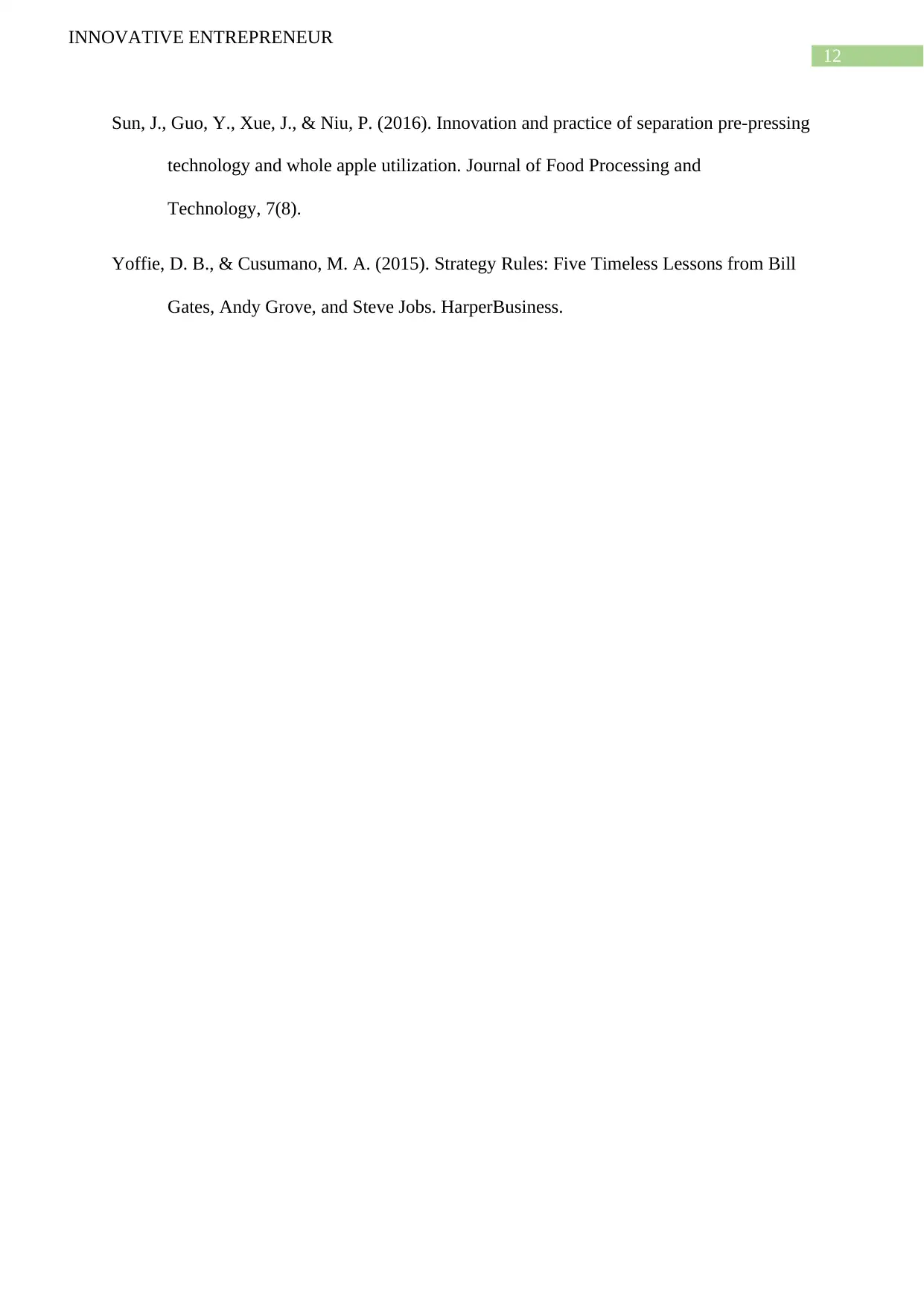
12
INNOVATIVE ENTREPRENEUR
Sun, J., Guo, Y., Xue, J., & Niu, P. (2016). Innovation and practice of separation pre-pressing
technology and whole apple utilization. Journal of Food Processing and
Technology, 7(8).
Yoffie, D. B., & Cusumano, M. A. (2015). Strategy Rules: Five Timeless Lessons from Bill
Gates, Andy Grove, and Steve Jobs. HarperBusiness.
INNOVATIVE ENTREPRENEUR
Sun, J., Guo, Y., Xue, J., & Niu, P. (2016). Innovation and practice of separation pre-pressing
technology and whole apple utilization. Journal of Food Processing and
Technology, 7(8).
Yoffie, D. B., & Cusumano, M. A. (2015). Strategy Rules: Five Timeless Lessons from Bill
Gates, Andy Grove, and Steve Jobs. HarperBusiness.
1 out of 13
Related Documents
Your All-in-One AI-Powered Toolkit for Academic Success.
+13062052269
info@desklib.com
Available 24*7 on WhatsApp / Email
![[object Object]](/_next/static/media/star-bottom.7253800d.svg)
Unlock your academic potential
© 2024 | Zucol Services PVT LTD | All rights reserved.





